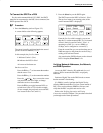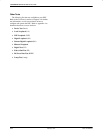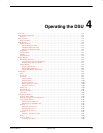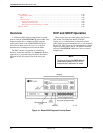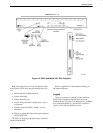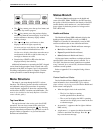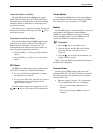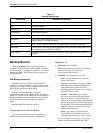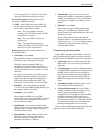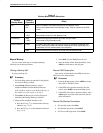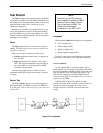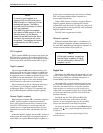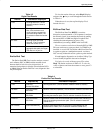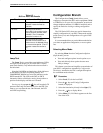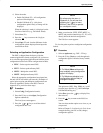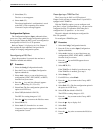
Operating the DSU
4-73550-A2-GB20-10 February 1995
If the tributary DSU is to initiate the call, set the
control for Cllbk and the tributary for Pswrd.
External DBU Option Set (This option set will
not appear if a DBM is installed.):
• ExtBU – Select whether the external DBU will
answer or place backup calls. The external DBU
must be able to support Dial on DTR.
Ansr – The external DBU will answer
incoming calls. The DBU must provide DSR
when the call is complete.
Orig – The external DBU will place an
outgoing call.
None – The external backup feature is
disabled. The DSU will not switch data to the
alternate port. (None is the default.)
Backup Option Set (None of these need to be set
for manual backup.):
• Auto Bckup – Select Enab.
When enabled, the DSU will automatically initiate
dial backup. Up to 10 attempts will be made.
If both the control and tributary DSUs are
configured for automatic backup, NtwkTimOut
should be set to different values so that the control
and tributary DSUs do not try to place a call at the
same time.
On a point-to-point circuit, it is best that only one
end performs automatic backup. It is possible to
trigger the backup for single-direction network
failures only detected at the remote DSU. The
remote DSU must have RTS Control set to FrcOn.
• Bckup Dir – Select the call directory identifier
(1 to 10) stored in the DBM’s Backup Directory for
the telephone number to be dialed.
• AutoRestor – Select Enab.
When enabled, the DBM or external DBU
automatically restores data to the DDS circuit when
service is restored and the amount of time set in
RestoreTimOut has expired.
• NtwkTimOut – Set the amount of time that the
DDS circuit must be out of service before a backup
attempt is made: from 0:00 (minutes:seconds) to
29:59 (the default is 0:20).
• RestorTimOut – Set the amount of time that the
DDS circuit must be back in service before
automatic restoration is attempted: from 1 to
60 minutes (the default is 5 minutes).
• TriesTimeOut – Specify the overall time limit
during which a DBM will automatically attempt to
establish a dial backup call: from 1 to 60 minutes
(the default is 15 minutes). Auto Bckup must be
enabled.
• MultiCall – Select Enab.
When enabled, instead of following the normal
calling cycle, the DBM cycles through all dial
strings contained in its Backup Directory until a call
attempt is successful.
Do not enable MultiCall unless more than one
telephone number is in the Backup Directory and
each successive (i.e., 1, 2, 3, etc.) telephone number
is different from the previous entry. Directory
entries should be unique.
Understanding Operating Modes
When a DSU is equipped with a DBM or an external
DBU, the Backup branch controls operation of the Dial
Backup function. The DBM has four modes of operation:
• In Idle mode, there is no dialed connection. The
DDS circuit is active and carrying user data and
diagnostics.
• In Standby mode, the unit has a dialed connection
to another DBM or compatible dial backup unit, but
the DDS circuit is still active and carrying user
data. The dialed digital circuit carries diagnostic
traffic addressed to either the tributary DSU or
DBM. These diagnostics do not disrupt the DDS
circuit.
• In Dial Backup mode, the dialed circuit is active
and carrying user data and diagnostics.
• In External Backup mode, the external DBU is
the DSU’s alternate connection with the remote
device. Depending upon how the DSU is
configured, the external DBU will either establish
the dialed connection (ExtBU set to Orig) or
respond to an incoming call (ExtBU set to Ansr).
Once the dialed connection is established, the DSU
switches data and diagnostics to the dialed link,
then drops backup when service is restored.
Table 4-2 lists the Backup branch operating modes and
explains the effects of each backup command.



